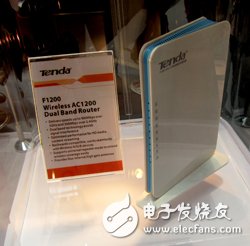The intensified competition of 802.11ac chip vendors has caused chip prices to fall sharply, attracting mobile device and wireless network sharer brands to increase their purchases and begin to introduce low- and mid-priced product series, which is expected to significantly increase 802.11ac in smartphones. , Tablet devices, notebook computers and Netcom equipment market penetration.
802.11ac market penetration is rapidly increasing. After chip vendors have launched low-cost solutions, manufacturers of smartphones, tablet devices, notebook computers and Netcom devices have increased the proportion of their products imported into 802.11ac chips, which is expected to accelerate the market penetration of 802.11ac.
Low-cost chip dumps out 11ac to grab into cheap mobile device
Faced with frequent price attacks by Qualcomm Atheros, MediaTek, Intel, Marvell, Realtek and other chip vendors, Broadcom also released the first 1 & TImes for the low-end market ; 1 802.11ac Combo Chip, actively expanding the market layout of smart phones, tablet devices and personal computers (PC) to consolidate its market share in the 802.11ac chip.

Figure 1 Rahul Patel, vice president of Broadcom ’s mobile and wireless business group, said that the new entry-level combination chip will help Broadcom expand its 802.11ac market.
Rahul Patel (Figure 1), vice president of Broadcom Mobile and Wireless Business Group, said that compared to 802.11n, 802.11ac data throughput (Throughput) is three times faster, coverage is up to two times, and battery life can be extended six times, so it can be Realize more ideal high-quality content streaming, reduce signal dead ends and power consumption, and achieve the goal of connecting several devices simultaneously. Not only is it more suitable for media streaming applications than 802.11n, but also helps to solve data traffic explosions Increased challenges.
Therefore, Broadcom has regarded 802.11ac as the main product line of the next stage of wireless local area network (Wi-Fi). Patel pointed out that Dell, Asus, LG, HTC, Samsung and other brands have successively launched high-end terminal products that introduce 802.11ac functions. However, in the future, 802.11ac will not be limited to high-end applications. It will further penetrate into the low-end market.
Seeing that competitors are aggressively attacking prices in the mid- to low-end mobile device market, Broadcom has also recently released an 802.11ac combination chip dedicated to the entry-level market, ready to rush to market. It is understood that the new product is designed with a single chip with a higher degree of integration, so it can reduce the overall bill of materials (BOM) cost of the original equipment manufacturer (OEM). Patel emphasized that the company's new product 1 & TImes; 1 design can reduce costs, will help OEMs fully explore the huge potential business opportunities of low-end mobile devices, and stabilize Broadcom's market position in 802.11ac. It is expected that in the second half of 2013, related terminal products Can come out.
According to estimates by the market research agency ABI Research, 802.11ac chips will be shipped in large quantities from 2013 and will be quickly and widely used in various devices, especially smartphones, notebook computers and tablet devices. It is expected that by 2014 It accounts for more than half of the total shipments of Wi-Fi chips.
While 802.11ac chip vendors are competing for low-cost solutions, Netcom equipment brands are also taking advantage of the low-cost products to make 802.11ac routers more affordable.
802.11ac market continues to increase the price of router manufacturers
Aiming at the huge business opportunities in the 802.11ac market, in addition to chip makers such as Broadcom and Qualcomm Atheros, which have competed to launch competitively priced solutions, router manufacturers such as TP-LINK, Tenda, and Douson have also offered ultra-low price promotions The plan (Figure 2), in order to get ahead of the 802.11ac market, the battle is on the verge.

Figure 2 Tenda exhibited a series of routers with built-in Broadcom 802.11ac chips at the 2013 Taipei International Computer Show.

Figure 3 Wang Hongwei, Director of Product Marketing of Tenda, emphasized that the built-in antenna of 802.11ac routers or the addition of unique design elements will become a major focus for manufacturers to create product differentiation.
Wang Hongwei (Figure 3), director of product marketing at Tenda, said that the Chinese mainland government has invested more than RMB 300 billion to build wireless cities, including 30 cities including Beijing, Tianjin, Shanghai, Hangzhou, and Guangzhou, which have successively launched wireless construction plans. Among them, Beijing, Hangzhou, Shenzhen and other cities have successively achieved the goal of full coverage of Wi-Fi by public transportation.
Wang Hongwei further pointed out that while communication construction is gradually improving, consumers have become accustomed to the experience of using high frequency bandwidth, high rate, and stable transmission, thus accelerating the wave of gradually replacing 802.11n solutions with tablets, mobile phones and Netcom products that support the 802.11ac standard .
It is understood that the price of 802.11ac chips in the first half of this year has been reduced by 30% compared with last year, and the second half of this year will still be able to drop by another 10? 20%, is expected to accelerate the release of cost-effective 802.11ac products.
In fact, routers equipped with 802.11ac were expensive last year, ranging from about NT $ 2,000 to NT $ 7,000. However, since May this year, there have been successive router manufacturers such as TP-Link, D-Link, etc. A router up and down RMB 200 (equivalent to about NT $ 970).
In addition, taking advantage of the strategic partnership with Broadcom, Tenda will also launch a series of cost-effective home and enterprise 802.11ac routers while the 802.11ac market is heating up. Wang Hongwei said that for the smart home audio and video transmission market, Tengda will launch 3 & TImes; 3 and 2 & TImes; 2 dual-band (2.4GHz / 5GHz) routers in the third quarter of this year, which will cost about RMB 500? 600 yuan (equivalent to about NTD) 2,400? 2,900 yuan); it is expected that under the trend of continued chip price dips and the market gradually heating up, Tengda will launch a 1 × 1 version with a price of only RMB 120 (about NTD 580) Entry-level router.
Most 802.11a / b / g / n devices use the 2.4GHz band, but 802.11ac operates on the 5GHz band. Therefore, if the router uses dual-band coverage technology, users can enjoy 802.11n and 802.11ac Wireless transmission rate. Taking the 2 × 2 scheme as an example, the transmission rate of the 802.11n band is 300Mbit / s, while the transmission rate of the 802.11ac band is 867Mbit / s, and the dual-band co-existing router can provide consumers with nearly 1,200Mbit / s transmission. Experience.
Wang Hongwei believes that driven by the trend of the Internet of Things (IoT), 802.11ac will not only become the standard equipment for mobile devices, but also will introduce a large number of home appliances and commercial application electronic products in the future to meet the needs of various types of smart networking. Specifications must also be upgraded synchronously to speed up the decommissioning of Netcom equipment. Therefore, Tengda will also launch a series of solutions equipped with 4 × 4 802.11ac chips in the first quarter of next year.
LED Usb Cable advantage:
Hot selling colors gradual change color Led Usb Cable flashing data charging cable for ios ,for android,100% Brand New and High Quality.
Standard USB 2.0 Cable.Start syncing your phone with a PC today through this premium quality Data Cable.All the Cellphones with Micro USB Port

LED USB Cable
Led Usb Cable,Durable Usb Cable,Mini Usb Adapter Cable,Led Light Usb Charger Cable
Dongguan City Leya Electronic Technology Co. Ltd , https://www.dgleya.com